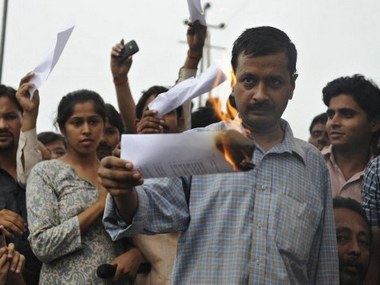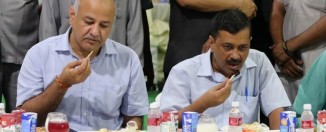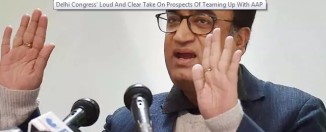Lumpenised and angry: Arvind Kejriwal redefined the ‘common man’
Few would be aware that LK Advani’s sartorial and facial resemblance to cartoonist RK Laxman’s ubiquitous ‘common man’ had worked to his advantage when he set out on his Ram Rathyatra in the 1990s. He was the likeable elderly neighbour next door for people in a large part of India, the quintessential ‘common man’ of the cartoonist’s imagination. Twenty-five years on, Advani has receded to the margins, but the ‘common man’ is still going strong after undergoing a metamorphosis.
The dhoti-clad man in his sixties has changed into a semi-urban aspiring young man in trousers and shirt; if it’s winter he dons a sweater and covers his face with a thick muffler. He represents an India that is getting demographically younger. He wears that hassled look perennially and is prone to exploding in anger every now and then. As Delhi Chief Minister Arvind Kejriwal goes into another fit of fury over his “exploitative subjugation” by the state, he fits into the description of the new common man perfectly.
Like Advani, Kejriwal gained immense political benefit from his carefully cultivated image of an archetypal representative of the neo-middle class. In that decade of Shah Bano case and the Mandir movement, Advani came up with new terminologies such as ‘minoritism’, ‘pseudo-secularism’, ‘justice for all / appeasement for none’ etc that appealed to the middle class Hindu voters. So also, Kejriwal. His idioms and language were far removed from the usual, fossilised political rhetoric. He was seen as a person who took up the cudgels on behalf of the ordinary people and was not afraid to challenge the hegemony of traditional political parties. He gave the impression of being an outsider determined to clean the Augean stables called politics.
Both these versions of the ‘common man’ were sincere and blunt, but still likeable for both the qualities. But that was some time ago. Kejriwal’s ‘common man’ has added deception and guile to its persona and is quite the politician he set out to be the counterfoil of. He is still angry but the anger is for unworthy causes.
In politics, deception often acquires more substance than reality. It came out sharply after one CBI raid at the office of Kejriwal’s principal secretary Rajendra Kumar. In a fit of anger, Kejriwal not only displayed intolerance of the worst order but used vocabulary fit for a lumpen to conduct the political discourse, calling the prime minister and the finance minister names. It was theatrics in full play.
And theatrics is an essential part of politics and the game of deception.
Kejriwal is cocksure of getting away with these indiscretions. This was the precise reason he launched a scathing attack against Modi and Arun Jaitley in a specially convened session of the Delhi Vidhan Sabha on Monday. In his speech, he tried to play to people’s emotions by referring to the prime minister’s foreign jaunts and his well-appointed big aircraft. “He has a big aircraft which is fitted with all luxuries,” he said in order to bring up the issue of disparity between the governing class and those governed.
Perhaps for the first time in the history of India, the Delhi assembly was used as a forum to attack directly not only the Centre but also the prime minister and the finance minister. There are unwritten traditions that neither state legislative bodies nor Parliament be used as a forum to run down constitutional entities. But Kejriwal doesn’t care about conventions, especially when he is supposed to honour them. No legislative body has ever been convened with the single-point of agenda of calling the prime minister of the country names. The elan with which he ran down the prime minister for breaking conventions (for not keeping the chief minister in the loop about a raid on his officer) while he was doing exactly the same, is an indicator of the extent to which he has mastered the art of politics and deception. There is all possibility that he would have sent an SHO of Ghaziabad or Noida to 7 RCR- the prime minister’s official residence had he been chief minister of Uttar Pradesh not Delhi.
Contrast his today’s petulant image with his sober and restrained one during the Anna Hazare movement, his deceptiveness becomes all too evident. For instance, in the initial days of politics, he scoffed at leaders for occupying big houses and travelling in air-conditioned cars with security escorts. As Delhi chief minister he has been relishing all those perks of power like any other traditional politician. He has been running away from providing efficient governance in Delhi on every flimsy pretext, the fight with the centre being the most important one. His splurging on self-promotion through government advertisements borders on megalomania of the worst kind, not uncommon in leaders like Akhilesh Yadav, J Jayalalitha and Mayawati.
In less than three years, the transformation of Kejriwal from ‘common man’ to a ‘lumpenised leader’ has been apparently seamless. He is hell-bent upon inventing conspiracies and enemies where none exist. With a bunch of associates equally at ease with his brand of politics, he continues to display a streak of intolerance to dissent. And he camouflages it all with some invisible larger cause as an excuse. He will not be averse to resorting to the worst kind of vituperative dialogue when its suits him.
Like Advani of 1990s whose commitment to Ram Mandir at Ayodhya was a sham, Kejriwal’s protestation about probity and corruption are a red-herring to gain political pre-eminence.





